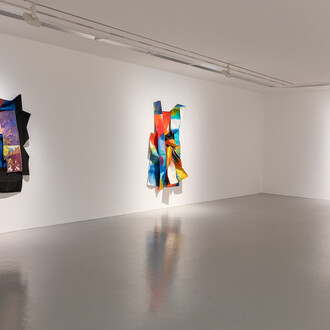Phoenix Rising: Art and Civic Imagination responds both to Dublin itself and to imaginary and ideal cities. The project references Dublin’s 1914 Civic Exhibition which was inspired by the work of Scottish biologist, sociologist and planner Patrick Geddes and which attempted to re-imagine Dublin as ‘the phoenix of cities’ during a period of economic, social and political strife. The 1914 exhibition comprised school garden displays, municipal and commercial exhibits, child welfare displays, butter making and dance competitions, arts and crafts displays, archaeological and historical exhibitions, a cinema and an American soda fountain. The founder of this gallery, Hugh Lane, decorated a room in scarlet, yellow and brown which he called ‘Futurism in Dublin’ and which was intended to ‘suggest a spirited idea of Perfect Health’. A town planning competition for Dublin was also held but due to the outbreak of war the adjudicators were unable to meet so a winner was not announced until 1916. Patrick Abercrombie and Sydney and Arthur Kelly from Liverpool took first prize. The winning scheme was not published until 1922 in a volume called Dublin of the Future which featured a frontispiece by Harry Clarke.
Phoenix Rising showcases contemporary artists' responses to the city using different strategies to understand the urban environment. The artists in the exhibition are Stephen Brandes, Mark Clare, Cliona Harmey, Vagabond Reviews, Stéphanie Nava and Mary-Ruth Walsh. The exhibition features sculpture, drawing, photography and video, which make for an original contemporary response to the city. Stephen Brandes has created a monumental wall piece; Mark Clare draws together the histories of realist painting, the provision of civic water supplies and international exhibitions; Cliona Harmey uses weather satellite imagery, including an image downloaded from the roof of The Hugh Lane, to explore the presence of invisible data in our cities; Mary-Ruth Walsh has created a video work dedicated to Norah Geddes, who was active in the provision of children’s garden playgrounds in Edinburgh and Dublin; Vagabond Reviews have collected from individuals working in the human sciences a library of missing titles for books that would illuminate our way of thinking about cities; Stéphanie Nava is showing an extract of an ongoing project which looks at the culture of urban food production.
A related series of talks and workshops for all ages will explore relevant themes. A film programme in January will include works by Patrick Keiller, Cleary and Connolly, Jef Cornelis and Anne Maree Barry.



















